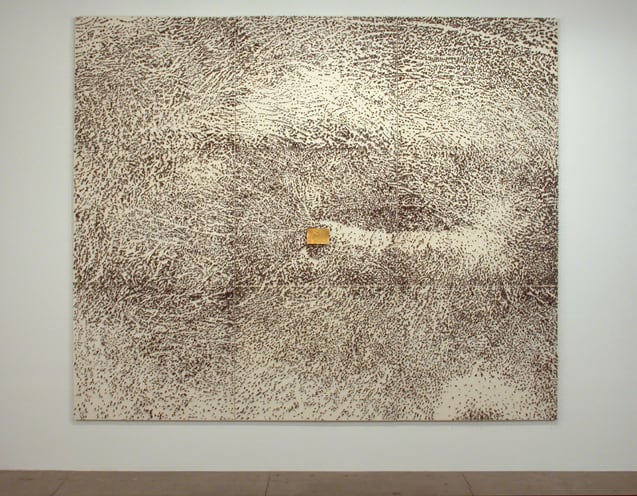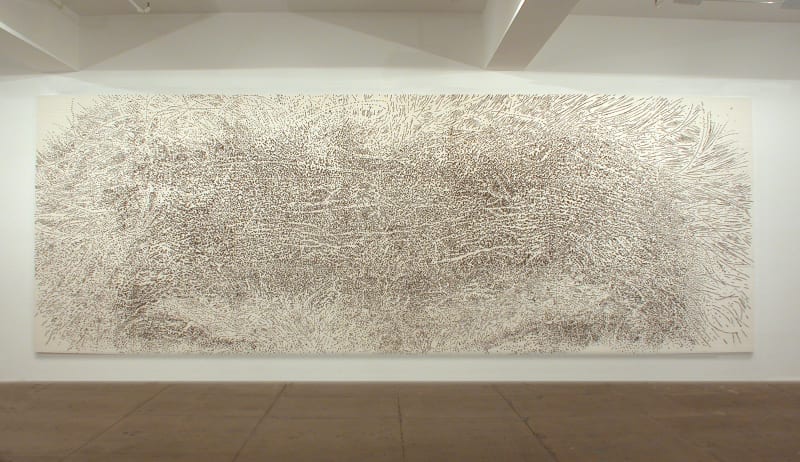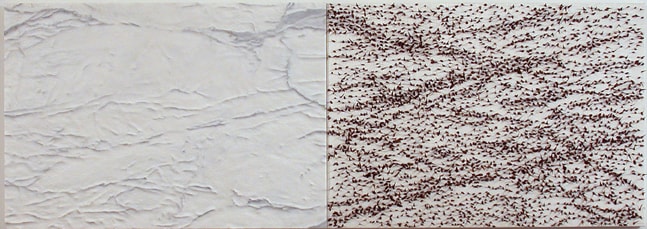Overview
Marian Goodman Gallery is pleased to announce an exhibition of recent sculpture by Giuseppe Penone, which will be on view from March 18th – May 3rd.
For the exhibition the artist, known for his imaginative use of materials, will present new works in bronze, marble, acacia thorns, and silk. The works fuse artistic forms with forms of nature and embody the dialectic that exists in Penone's work between the natural and the human, the ephemeral and the permanent. Insisting on a feeling for process and materials, the show includes Respirare L'Ombra (To Breathe the Shadow), a freestanding sculpture of laurel leaves and twigs cast in bronze, suggesting a human figure. Pelle di Marmo au Spine d'Acacia, a large wall piece made of a skin of marble and acacia thorns, will be accompanied by a series of three double-panel works in marble with vein-like markings carved and embedded within the body of the stone, each with an adjoining panel of acacia thorns thrusting through silk.
Giuseppe Penone
March 18 - May 3, 2003
Opening Reception: Tuesday, March 18, 6-8 pm
Marian Goodman Gallery is pleased to announce an exhibition of recent sculpture by Giuseppe Penone, which will be on view from March 18th – May 3rd.
For the exhibition the artist, known for his imaginative use of materials, will present new works in bronze, marble, acacia thorns, and silk. The works fuse artistic forms with forms of nature and embody the dialectic that exists in Penone's work between the natural and the human, the ephemeral and the permanent. Insisting on a feeling for process and materials, the show includes Respirare L'Ombra (To Breathe the Shadow), a freestanding sculpture of laurel leaves and twigs cast in bronze, suggesting a human figure. Pelle di Marmo au Spine d'Acacia, a large wall piece made of a skin of marble and acacia thorns, will be accompanied by a series of three double-panel works in marble with vein-like markings carved and embedded within the body of the stone, each with an adjoining panel of acacia thorns thrusting through silk.
The link between man, nature and time has existed as a constant motif in Penone's art since the late 60's, and has been at the basis of his lifelong production of sculpture, drawings, photographs, and installations. His investigation of the twofold aspect of nature-- man's grounding in the material world and the material world's conversion by man--has been demonstrated in a body of work which incorporates binary meanings related to the natural world and to the notion of living sculpture. The physical world has often been the point of departure for Penone, resulting in metaphorical correspondences between creation and the act of breath, for instance--the gesture, the trace, the space of breathing, the imprint of the eye or the hand, or the juncture of nature and the human body, as in the unity between the tree and the 'vertebrae' of life.
Giuseppe Penone was born in Garessio, Italy in 1947 and earned his diploma in sculpture from the Accademia de Belle Arte, Turin in 1970. Initially associated with arte povera and the group of artists who became known as the Turin School, his work relates also to the emergence of Land Art and Earth Works throughout the United States and Europe. He is the recent recipient of the Schock
Prize for the Visual Arts—reconciling nature and civilization—in 2001 from the Kungl Vetenskapsakademien, at The Royal Swedish Academy of Science, Stockholm. In 2001 he realized a commission for the town of Rotterdam, a bronze tree ten metres high, titled Elevazione, and in 1999 he completed a public project and commission for the Jardin Tuileries in Paris, France under the auspices of the French Ministry of Culture. Upcoming projects will include a solo exhibition at The Drawing Center, New York, scheduled to open in September, 2003, and a one-man show at the Centre Georges Pompidou, Paris, scheduled for the Spring of 2004.
Penone's work was recently seen in survey exhibitions devoted to the work of arte povera, including Zero to Infinity: Arte Povera 1962-1972, organized by The Walker Art Center, Minneapolis and the Tate Modern, London that toured to MOCA, Los Angeles and the Hirshhorn Museum and Sculpture Garden, Washington, D.C.; as well as Arte Povera from the Castello di Rivoli Collection, held at the Museum of Contemporary Art, Sydney, Australia. Solo exhibitions over the past five years have been seen at Spazio per l'arte Contemporanea, Bella Monaca, Rome; the Synagogue Stommeln, Pulheim-Stommeln, Germany; Rennes Espace in Paris; De Pont Foundation for Contemporary Arts, Tilburg, The Netherlands; Totoya Municipal Museum of Art, Toyota Aichi, Japan; and the Carré d'Art, Musée d'art contemporain, Nîmes. A retrospective survey of his work Giuseppe Penone: 1968-1998 was shown in 1999 at the CGAC, Centro Galego de Arte Contemporanea, Santiago de Compostela, Spain, and was accompanied by a catalogue. The catalogue by Germano Celant Giuseppe Penone (Electa, 1989) will be available for sale during the exhibition.











